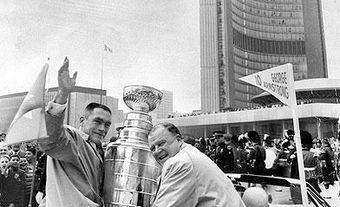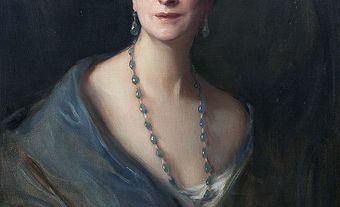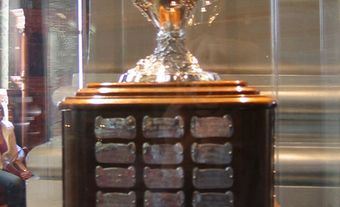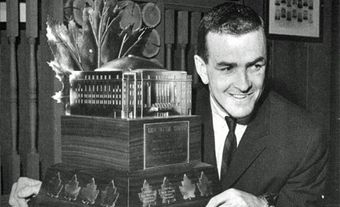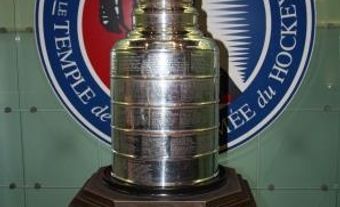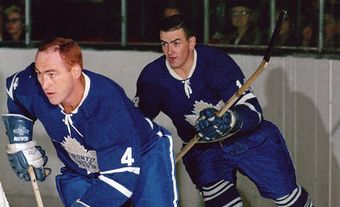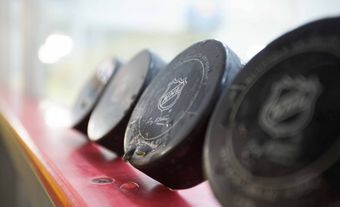David Michael Keon, hockey player (born 22 March 1940 in Noranda, Quebec). Dave Keon was voted the greatest player in Toronto Maple Leafs franchise history in 2016. A natural goal scorer who played great defense, Keon was regarded as a technically perfect player: durable, tenacious, rarely penalized and one of the fastest skaters in the NHL. After winning the Calder Memorial Trophy as the NHL’s rookie of the year in 1961, he went on to win four Stanley Cups with the Maple Leafs, including in 1967, when he received the Conn Smythe Trophy as playoff MVP. He won the Lady Byng Memorial Trophy for “sportsmanship and gentlemanly conduct” twice and also received the World Hockey Association’s sportsmanship award twice later in his career. He was inducted into the Hockey Hall of Fame, the Québec Sports Hall of Fame, the Ontario Sports Hall of Fame and Canada’s Sports Hall of Fame.

Early life
Dave Keon was born in Noranda, Quebec. He was the first of six children born to Laura (née Sloan), a schoolteacher, and David Herbert Keon, a miner at the Quemont Mine. Dave’s role model growing up was Tod Sloan, an older cousin who played with the Toronto Maple Leafs in the late 1940s.
Keon showed great promise as a juvenile. The Detroit Red Wings wanted him to move south to prepare to play for their junior hockey club in Burlington, Ontario, but his parents were not yet willing to let him move away. To secure Keon’s rights, the Maple Leafs spent $1,000 to sponsor Keon’s Noranda Lions juvenile team.
St. Michael’s
Keon was then invited to attend St. Michael’s School in Toronto, a boarding school offering a Roman Catholic education. The young centre played for the school’s junior-B team, the Buzzers, for one season, winning the league’s rookie of the year award in 1956–57.
He graduated to the junior-A team the following season, leading the St. Michael’s Majors in scoring with 23 goals and 27 assists in 45 games. General manager Father David Bauer and coach Bob Goldham instilled in Keon the virtues of a two-way work ethic and taught him how to play without the puck. They convinced him he would get to the National Hockey League (NHL) quicker if was also able to check opponents as well as score goals.
Stanley Cup Seasons

Keon jumped from junior hockey to the NHL at age 20. His standout performance at training camp led to his surprise addition to the Maple Leafs roster for the 1960–61 season. He scored 20 goals with 25 assists in 70 games. Keon handily won the Calder Memorial Trophy as the NHL’s rookie of the year. In 1963, Peter N. Allison of Maclean’s magazine called the 23-year-old Keon “the best player in hockey.”
Keon played a crucial role with the Maple Leafs. The team won three consecutive Stanley Cups from 1962–64 before adding another in 1967; that year, Keon was awarded the Conn Smythe Trophy as the most valuable player in the playoffs. (See also Toronto Maple Leafs 1967: The Last Stanley Cup.) The 5-foot-9, 165-pound (1.75-m, 74.8-kg) centre was always a threat to score and checked tenaciously. His ability to do so without drawing penalties showed his skill at positioning. He won the Lady Byng Memorial Trophy for “sportsmanship and gentlemanly conduct” for the 1961–62 and 1962–63 seasons. He was assessed a single minor penalty in each of those campaigns. Keon only registered eight minor penalties (16 minutes) in his first four seasons in the NHL and only 36 minutes in his first eight seasons.
Keon earned superlatives for his skill and style of play. He was a pesky forechecker and was regarded as perhaps the fastest skater in the league. The sportswriter Andy O’Brien wrote that Keon’s “skates seem to caress rather than dig into the ice,” while coach Punch Imlach noted Keon “played with bulldog tenacity.” In the 1970–71 season, he scored eight short-handed goals to set an NHL record. (Mario Lemieux broke the record in 1988–89, with 13).
Captaincy
Keon was named captain of the Maple Leafs in 1969 after George Armstrong retired. Keon took the position at a time of cultural change in hockey. The same forces sweeping through society were also influencing younger players, who were no longer as likely to blindly follow authority. (See also Baby Boomers in Canada; Hippies in Canada.) In time, Keon would be criticized by team owner Harold Ballard for not displaying leadership. Keon’s contract squabbles and other indignities led to a long estrangement from the club.
World Hockey Association
The arrival of the World Hockey Association (WHA) as a rival to the NHL gave players greater leeway in contract negotiations. A proposed team in Ottawa drafted Keon, making it clear they were interested in having him on the roster. Because of the suspicion he was about to switch leagues, Keon was not put on the Team Canada roster for the 1972 Summit Series against the Soviet Union.
In 1975, Keon signed a free-agent contract with the WHA’s Minnesota Fighting Saints. He spent four seasons in the league; he also played for the Indianapolis Racers and the New England Whalers. He was awarded the Paul Deneau Trophy as the WHA’s most gentlemanly player in 1976–77 and 1977–78.
Return to the NHL
The Whalers were one of four WHA teams that joined the NHL in 1979 (the Edmonton Oilers, Quebec Nordiques and Winnipeg Jets were the others). The team, based in Hartford, Connecticut, included several former NHL all-stars, including Keon, Bobby Hull and Gordie Howe. Keon retired at the end of the 1981–82 season.
In 18 NHL seasons, Keon scored 396 goals with 590 assists. Remarkably, he had only 117 penalty minutes. In 92 playoff games, he scored 32 goals with 36 assists and only six penalty minutes. In four WHA seasons, he scored 102 goals with 189 assists and was called for 11 minor penalties.
Estrangement from Maple Leafs
After retiring from hockey, Keon moved to South Florida, where he worked in real estate. For years, he rebuffed invitations to take part in events sponsored by the Maple Leafs. After Brendan Shanahan became team president in 2014, he deliberately sought to thaw the relationship between the club and Keon.
Honours
Keon was inducted into the Hockey Hall of Fame in 1986. He has also been enshrined in the Québec Sports Hall of Fame (2016), Canada’s Sports Hall of Fame (2018) and the Ontario Sports Hall of Fame (2019).
In 2016, as the Maple Leafs approached their centennial, a 31-member panel of hockey experts selected Keon as the greatest player in franchise history. A bronze statue depicting him as a 29-year-old player was added to Legends Row at the Air Canada Centre (now Scotiabank Arena) in Toronto. In 2017, as the NHL celebrated its 100th anniversary, it included Keon in its list of the 100 greatest NHL players.
In 2008, Keon’s former junior team, since renamed the Mississauga St. Michael’s Steelheads, retired the No. 9 sweater he wore with the St. Michael’s Majors. In 2016, the Maple Leafs retired his No. 14 sweater. The club had previously honoured the number by hanging it from the rafters of the home arena.
See also Toronto Maple Leafs 1967: The Last Stanley Cup.
Awards
- Calder Memorial Trophy, NHL (1961)
- Conn Smythe Trophy, NHL (1967)
- Lady Byng Memorial Trophy, NHL (1962, 1963)
- Inductee, Hockey Hall of Fame (1986)
- Inductee, Québec Sports Hall of Fame (2016)
- Inductee, Canada’s Sports Hall of Fame (2018)
- Inductee, Ontario Sports Hall of Fame (2019)
- Paul Deneau Trophy, WHA (1977, 1978)

 Share on Facebook
Share on Facebook Share on X
Share on X Share by Email
Share by Email Share on Google Classroom
Share on Google Classroom
